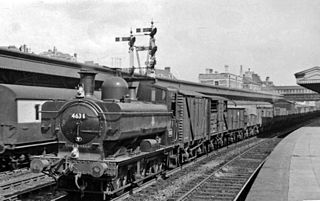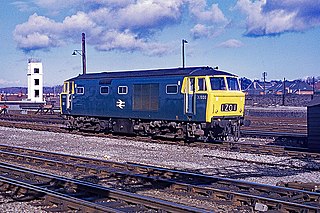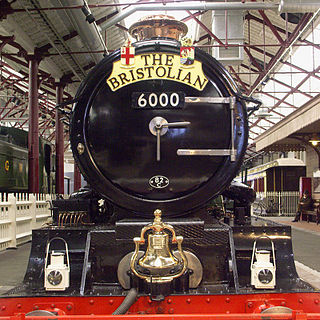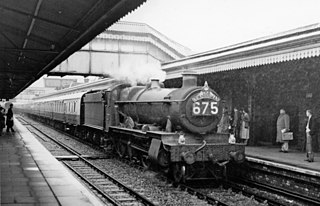
The Great Western Railway (GWR) was a British railway company that linked London with the southwest, west and West Midlands of England and most of Wales. It was founded in 1833, received its enabling Act of Parliament on 31 August 1835 and ran its first trains in 1838 with the initial route completed between London and Bristol in 1841. It was engineered by Isambard Kingdom Brunel, who chose a broad gauge of 7 ft —later slightly widened to 7 ft 1⁄4 in —but, from 1854, a series of amalgamations saw it also operate 4 ft 8+1⁄2 in standard-gauge trains; the last broad-gauge services were operated in 1892.

The British Rail Class 52 is a class of 74 Type 4 diesel-hydraulic locomotives built for the Western Region of British Railways between 1961 and 1964. All were given two-word names, the first word being "Western" and thus the type became known as Westerns. They were also known as Wizzos and Thousands.

InterCity was introduced by British Rail in 1966 as a brand-name for its long-haul express passenger services.

The British Railways Standard Class 9F 2-10-0 is a class of steam locomotive designed for British Railways by Robert Riddles. The Class 9F was the last in a series of standardised locomotive classes designed for British Railways during the 1950s, and was intended for use on fast, heavy freight trains over long distances. It was one of the most powerful steam locomotive types ever built for British Railways, and successfully performed its intended duties. The class was given the nickname of 'Spaceships', due to its size and shape.

The steam locomotives of British Railways were used by British Railways over the period 1948–1968. The vast majority of these were inherited from its four constituent companies, the "Big Four".

BR Standard Class 9F number 92220 Evening Star is a preserved British steam locomotive completed in 1960. It was the last steam locomotive to be built by British Railways. It was the only British main line steam locomotive earmarked for preservation from the date of construction. It was the 999th locomotive of the whole British Railways Standard range.

The BR Standard Class 7, otherwise known as the Britannia Class, is a class of 4-6-2 Pacific steam locomotive designed under Robert Riddles for use by British Railways for mixed-traffic duties. 55 were constructed between 1951 and 1954. The design employed results from the 1948 locomotive exchanges undertaken in advance of further locomotive classes being constructed. Three batches were constructed at Crewe Works, before the publication of the 1955 Modernisation Plan.

Rail Express Systems (RES) was a sector of British Rail. This sector was responsible for transport of mail and parcels, including the travelling post office trains, as well as taking over charter operations from InterCity and haulage of the Royal Train.

The British Rail Class 50 is a class of diesel locomotives designed to haul express passenger trains at 100 mph (160 km/h). Built by English Electric at the Vulcan Foundry in Newton-le-Willows between 1967 and 1968, the Class 50s were initially on a 10-year lease from English Electric Leasing, and were employed hauling express passenger trains on the, then non-electrified, section of the West Coast Main Line between Crewe and Scotland. Initially numbered D400–D449 and known as English Electric Type 4s, the locomotives were purchased outright by British Rail (BR) at the end of the lease and became Class 50 in the TOPS renumbering of 1973.

The GWR 5700 Class, or 57xx class, is a class of 0-6-0 pannier tank steam locomotive, built by the Great Western Railway (GWR) and British Railways (BR) between 1929 and 1950. With 863 built, they were the most prolific class of the GWR, and one of the most numerous classes of British steam locomotive.

The British Rail Class 42 Warship diesel-hydraulic locomotives were introduced in 1958. It was apparent at that time that the largest centre of expertise on diesel-hydraulic locomotives was in West Germany. The Western Region of British Railways negotiated a licence with German manufacturers to scale down the German Federal Railway's "V200" design to suit the smaller loading gauge of the British network, and to allow British manufacturers to construct the new locomotives. The resultant design bears a close resemblance, both cosmetically and in the engineering employed, to the original V200 design. Warship locomotives were divided into two batches: those built at BR's Swindon works were numbered in the series D800-D832 and D866-D870, had a maximum tractive effort of 52,400 pounds-force (233,000 N) and eventually became British Rail Class 42. 33 others, D833–D865, were constructed by the North British Locomotive Company and became British Rail Class 43. They were allocated to Bristol Bath Road, Plymouth Laira, Newton Abbot and Old Oak Common.

The British Rail Class 35 is a class of mixed-traffic B-B diesel locomotive with hydraulic transmission. Because of their Mekydro-design hydraulic transmission units, the locomotives became known as the Hymeks. They were numbered D7000-D7100.

The Bristolian is a named passenger train service from London Paddington to Bristol Temple Meads. It starts at Weston-super-Mare in the London-bound direction.
The history of rail transport in Great Britain 1948–1994 covers the period when the British railway system was nationalised under the name of 'British Railways', latterly known as British Rail until its eventual privatisation in 1994.

Pullman trains in Great Britain were mainline luxury railway services that operated with first-class coaches and a steward service, provided by the British Pullman Car Company (PCC) from 1874 until 1962, and then by British Railways from 1962 until 1972. Many named mainline service trains have subsequently used the word 'Pullman' in their titles, but most of these have been normal trains with increased first-class accommodation. Since 1982 however, some railtours have been operated by companies using Pullman coaches dating from the 1920s to 1950s to recreate the ambience of the heyday of Pullman travel.

The Cornishman was a British express passenger train to Penzance in Cornwall. From its inception in the 19th century until before World War II it originated at London Paddington. Under British Railways the name was applied to a different service, starting variously from Wolverhampton, Leeds or Bradford.

The history of British Rail's corporate liveries is quite complex. Although from the mid-1960s to the 1980s the organisation was associated with "Rail Blue", a number of other schemes were also used, especially when it was split into operating units or "sectors" in the mid-1980s.

From 1920, the cab side of Great Western Railway (GWR) steam locomotives bore a letter on a coloured disc, which enabled staff to quickly assess the capabilities of locomotives without the need to check tables of data. The letter showed the power classification, and the coloured disc showed the weight restriction. This system continued after the GWR became the Western Region of British Railways.

The Cathedrals Express was a named passenger express introduced in 1957 on the Western Region of British Railways. It connected the cathedral cities of Hereford and Worcester to London Paddington.

The Merchant Venturer was a named train of British Railways. It ran over eleven Summer seasons from 3 May 1951 to 9 September 1961.




















